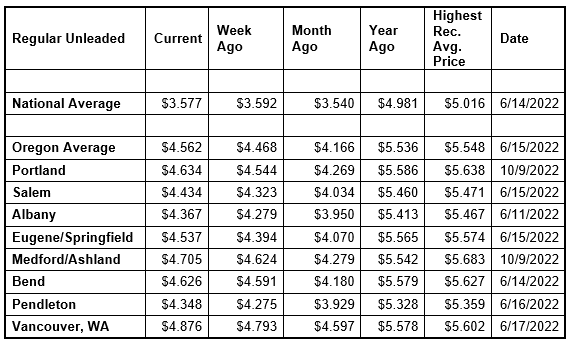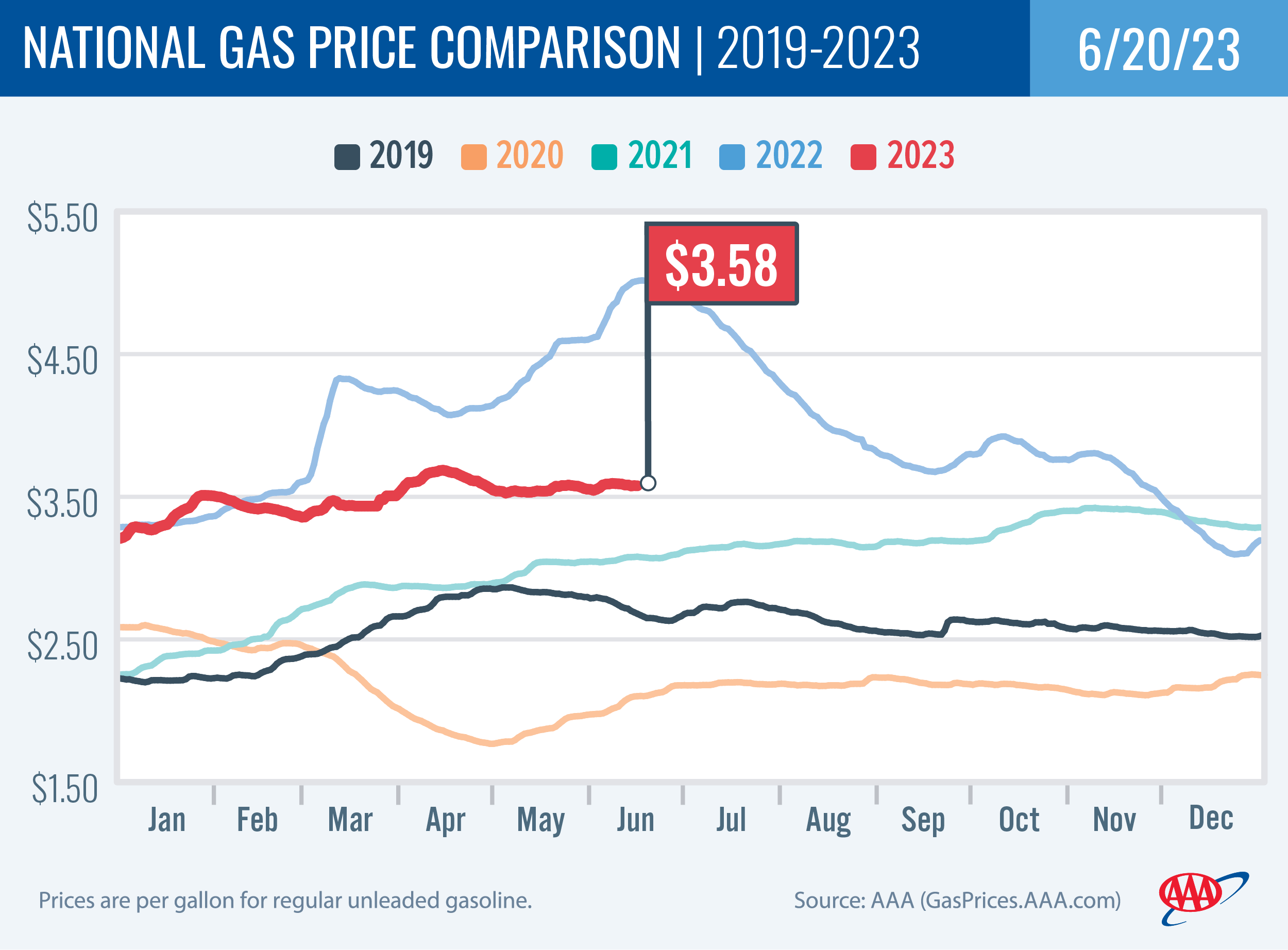Oregon average jumps nine cents which is the largest weekly gain in the nation
PORTLAND, Ore., – It’s a mixed bag for gas prices this week with about half of the states seeing small to moderate increases and the other half with small to moderate declines. Maintenance on the Olympic Pipeline has caused prices to rise in Oregon and Washington; in fact, Washington has the most expensive gas in the nation. For the week, the national average for regular dips a penny to $3.58 a gallon. The Oregon average rises nine cents to $4.56. This is the largest weekly jump in the nation.

Scheduled work on BP’s Olympic pipeline has caused wholesale prices in the Pacific Northwest to climb. The Olympic pipeline runs along a 299-mile route from Blaine, Washington to Portland, Oregon, and transports gas, diesel, and jet fuel from four Puget Sound refineries. Wholesale prices for gasoline in Oregon and Washington are the highest in the country which is why retail prices here are climbing.
“Gasoline supplies are already fairly tight with demand in the U.S. above nine million barrels a day for the fourth week in a row. Factor in the work being done on the Olympic pipeline, and that’s a recipe for rising pump prices in Oregon and Washington,” says Marie Dodds, public affairs director for AAA Oregon/Idaho. “Relatively low crude oil prices in the upper $60s and low $70s are helping to keep pump price hikes from being dramatic this week.”
Crude oil prices remain below $75 per barrel, despite the announcement in early June from the Organization of the Petroleum Exporting Countries and other major oil producers, including Russia, known collectively as OPEC+, that it would extend production cuts of more than 1 million b/d through 2024. OPEC+ first announced the production cuts at its April meeting and said the cuts would be in effect through 2023. OPEC+ pumps about 40% of the world’s crude oil.
Crude oil is trading around $71 today compared to $69 a week ago and $111 a year ago. In May, West Texas Intermediate ranged between about $63 and $77 per barrel. In April, WTI ranged between about $73 and $83. In March, WTI ranged between about $64 and $81 per barrel. In February, WTI ranged between about $73 and $80 per barrel. In January, WTI ranged between about $73 and $82 bbl. Crude reached recent highs of $123.70 on March 8, 2022, shortly after the Russian invasion of Ukraine, and $122.11 per barrel on June 8, 2022. The all-time high for WTI crude oil is $147.27 in July 2008.
Crude oil is the main ingredient in gasoline and diesel, so pump prices are impacted by crude prices on the global markets. On average, about 56% of what we pay for in a gallon of gasoline is for the price of crude oil, 20% is refining, 11% distribution and marketing, and 14% are taxes, according to the U.S. Energy Information Administration.
Demand for gasoline in the U.S. demand decreased slightly from 9.22 to 9.19 million b/d for the week ending June 9. This compares to 9.09 million b/d a year ago. Meanwhile, total domestic gasoline stocks rose by 2.1 million bbl to 220.9 million bbl. Lower gas demand amid increasing supply has helped to limit pump price increases. If demand remains similar, pump prices will likely fluctuate moderately through next week.
Quick stats
Oregon is one of 24 states and the District of Columbia with higher prices now than a week ago. Oregon (+9 cents) has the largest weekly jump. Arizona (-12 cents) has the largest weekly decrease.
After 15 weeks, Washington ($4.91) bumps California ($4.87) as the state with the most expensive gas in the nation. Hawaii ($4.73) is third, Oregon ($4.56) is fourth, Nevada ($4.27) is fifth, Arizona ($4.14) is sixth, Alaska ($4.08) is seventh, Utah ($4.04) is eighth, and Illinois ($4.02) is ninth. These are the nine states with averages at or above $4 a gallon, up from eight states last week. This week 41 states and the District of Columbia have averages in the $3-range. There are no states with averages in the $2 range this week, down from one state a week ago.
The cheapest gas in the nation is in Mississippi ($3.01) and Arkansas ($3.13). For the 127th week in a row, no state has an average below $2 a gallon.
The difference between the most expensive and least expensive states is $1.90 this week, same as a week ago.
Oregon is one of 33 states and the District of Columbia with higher prices now than a month ago. The national average is four cents more and the Oregon average is 40 cents more than a month ago. This is the largest monthly increase in the nation. Washington (+31 cents) has the second-largest monthly jump. Arizona (-50 cents) has the largest monthly drop.
All 50 states and the District of Columbia have lower prices now than a year ago. The national average is $1.40 less and the Oregon average is 97 cents less than a year ago. Delaware (-$1.61) has the largest yearly drop. Washington (-63 cents) has the smallest. Last year, pump prices rose rapidly after the Russian invasion of Ukraine.
West Coast
The West Coast region continues to have the most expensive pump prices in the nation with all seven states in the top 10. It’s typical for the West Coast to have six or seven states in the top 10 as this region tends to consistently have fairly tight supplies, consuming about as much gasoline as is produced. In addition, this region is located relatively far from parts of the country where oil drilling, production and refining occurs, so transportation costs are higher. And environmental programs in this region add to the cost of production, storage and distribution.
| Rank | Region | Price on 6/20/23 |
| 1 | Washington | $4.91 |
| 2 | California | $4.87 |
| 3 | Hawaii | $4.73 |
| 4 | Oregon | $4.56 |
| 5 | Nevada | $4.27 |
| 6 | Arizona | $4.14 |
| 7 | Alaska | $4.08 |
| 8 | Utah | $4.04 |
| 9 | Illinois | $4.02 |
| 10 | Idaho | $3.98 |
As mentioned above, after 15 weeks Washington bumps California as the state with the most expensive gas in the nation. California slips to second, with Hawaii, Oregon, Nevada, Arizona and Alaska rounding out the top seven. Oregon is fourth for the second week in a row.
States in the West Coast region are seeing small to moderate changes on the week, just like every other state: Arizona (-12 cents), Oregon (+9 cents), Washington (+8 cents), Alaska (+3 cents), California (-3 cents), Nevada (-3 cents), and Hawaii (-6/10th of a cent).
The refinery utilization rate on the West Coast fell from 93.1% to 89.7% for the week ending June 9. This rate has ranged between about 73% to 93% in the last year. The latest national refinery utilization rate is 93.7%.
According to EIA’s latest weekly report, total gas stocks in the region decreased slightly from 29.65 million bbl. to 29.57 million bbl.
A lower refinery utilization rate and a decrease in gasoline stocks can put upward pressure on pump prices.
Oil market dynamics
Crude oil prices rose last week but then fell to start this week on worries over the pace of Chinese economic growth. Additionally, the EIA reported that total domestic commercial crude inventories increased significantly by 7.9 million bbl to 467.1 million bbl last week.
At the close of Friday’s formal trading session, WTI rose $1.16 to settle at $71.78. U.S. markets were closed Monday in observance of Juneteenth. Today crude is trading around $71, compared to $69 a week ago. Crude prices are about $46 less than a year ago.
Drivers can find current gas prices along their route with the free AAA Mobile app for iPhone, iPad and Android. The app can also be used to map a route, find discounts, book a hotel and access AAA roadside assistance. Learn more at AAA.com/mobile.

Diesel
For the week, the national average slips two cents to $3.89 a gallon. The record high is $5.816 set on June 19, 2022. The Oregon average adds a penny to $4.42. The record high is $6.47 set on July 3, 2022. A year ago the national average for diesel was $5.82 and the Oregon average was $6.31.
Find current fuel prices at GasPrices.AAA.com.
AAA news releases, high resolution images, broadcast-quality video, fact sheets and podcasts are available on the AAA NewsRoom at NewsRoom.AAA.com.
Find local news releases at https://oregon.aaa.com/community/media/media-contacts.html
Fuel prices are updated daily at AAA’s Daily Fuel Gauge at AAA Gas Prices. For more info go www.AAA.com. AAA Oregon/Idaho provides more than 880,000 members with travel, insurance, financial and automotive-related services, and is an affiliate of AAA National, serving more than 63 million motorists in North America.

